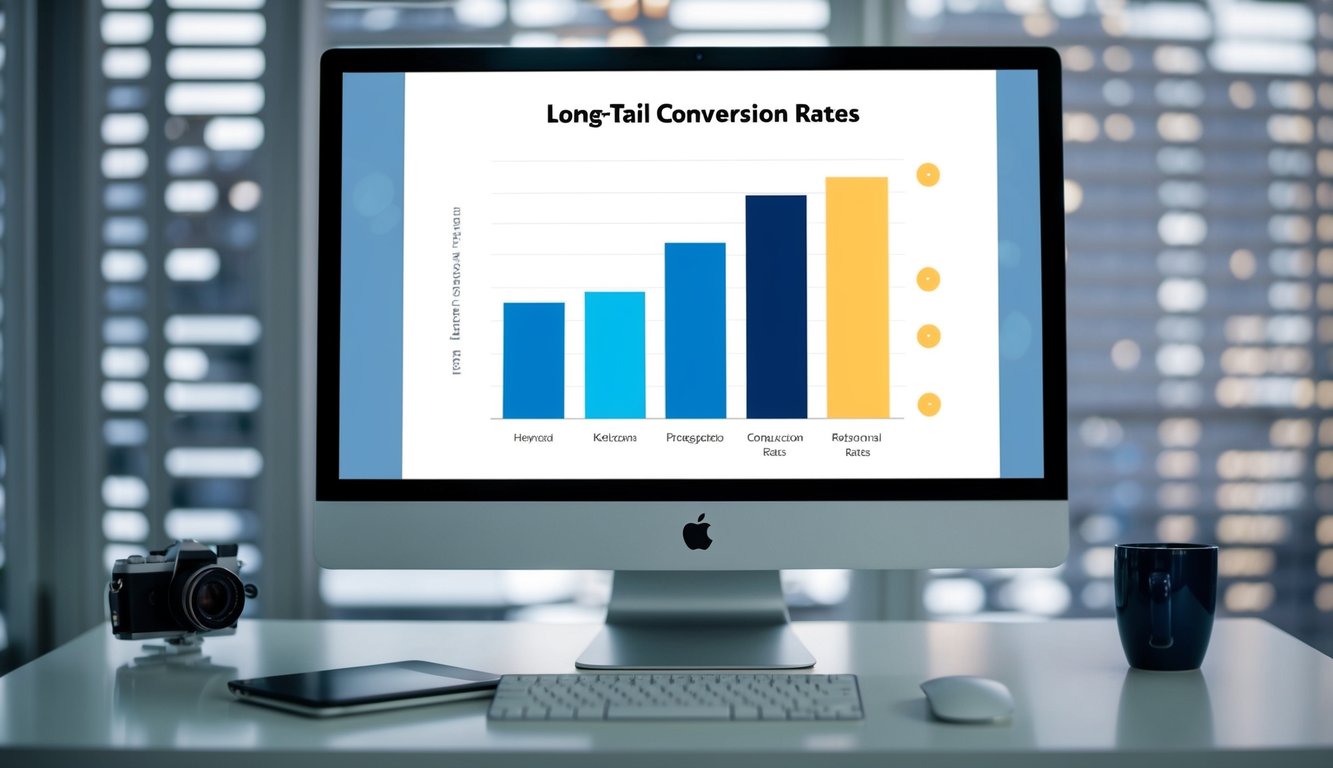The Role of Long-Tail Keywords in Boosting Conversion Rates for Businesses
Long-tail keywords might seem like the quiet kids in the corner of the SEO playground, but they pack a powerful punch when it comes to boosting your business’s conversion rates.
By targeting specific phrases that potential customers are likely typing into their search bars, these keywords can draw in targeted traffic ready to make a purchase. Imagine capturing an audience that’s not just browsing but is practically waving their credit card in front of the screen.

Because long-tail keywords are typically less competitive, they can help your content rank higher with less effort and expense compared to more generic terms.
Your audience gets exactly what they’re searching for, and you get more effective results. In today’s digital marketplace, businesses that ignore the potential of these more intricate search terms might be shutting the door on countless conversion opportunities.
Whether you’re crafting your next piece of content or revamping your SEO strategy, understanding how to use long-tail keywords effectively can provide a significant edge.
Instead of casting a wide net that catches anything and everything, you’ll be fishing with a spear—targeted, precise, and ever so much more satisfying when you reel in the right audience.
Key Takeaways
- Long-tail keywords drive higher conversion rates.
- They enhance SEO and lower competition.
- Effective implementation maximizes targeted traffic.
Understanding Long-Tail Keywords
Long-tail keywords are your undercover agents in the SEO world. They sneak in and grab the attention of exactly the audience you need by aligning closely with user intent.
Think of them as the detail-oriented detectives of keyword strategy, ensuring you aren’t casting too wide a net.
Definition and Characteristics
Long-tail keywords are phrases typically three or more words in length. Unlike broad, generic terms, they zero in on specific user queries, allowing you to target niche markets that might otherwise be overlooked. These keywords are highly specific and often have lower search volumes, but they bring in high-quality traffic.
By using long-tail keywords, you’re not just hoping to get on the first page of Google. You’re weaving a more intricate web that captures readers who are closer to making a purchase decision. These keywords appeal to the more discerning audience who knows exactly what they’re searching for.
Differences Between Short-Tail and Long-Tail Keywords
Let’s address the 200-pound gorilla in the room—the classic short-tail keywords. These are broad, one- or two-word terms like “shoes” or “weather.” They attract high traffic but lack the specificity that often leads to conversions. They cast a wide net, great for building awareness but not as effective for conversion.
In contrast, long-tail keywords like “affordable running shoes for women” are your precision-targeted tools. They have a lower search volume, sure, but that’s not a downside—it’s a strategy. These keywords cater to users further along in the buying process, making them more likely to convert. Utilizing them effectively means you can dominate niche markets and improve your conversion rates.
Advantages of Long-Tail Keywords
You might think all keywords are created equal, but in the world of SEO, some are definitely more equal than others. Long-tail keywords, for instance, are the secret sauce to targeting specific customer needs, reducing competition, and boosting your PPC campaign efficiency. Let’s break down why you can’t afford to ignore them.
Targeting Specific Customer Intent
Long-tail keywords allow you to tap directly into the minds of your potential customers. Unlike broad keywords that cast a wide, sometimes irrelevant net, these are precision-guided missiles. They target those rare, intent-rich queries that users type when they know exactly what they’re hunting for.
When someone searches for something specific, like “black leather designer shoes for women,” they’re not just browsing; they’re ready to take action. By optimizing for such phrases, you intercept highly motivated buyers in the midst of decision-making. Embedding long-tail keywords in your content improves relevance and positions you as the go-to expert for all niche queries.
Lower Competition and Higher Conversion Rates
Long-tail keywords don’t only capture intent—they’re also your best friends in reducing SEO competition. It’s like walking into a store with an exclusive product that no one else offers.
These keywords have a lower search volume, but less competition means you have a golden opportunity to rank higher on search engines without an SEO arm-wrestling match.
The beauty of this strategy is that higher rankings lead to increased conversion rates. You capture a precise audience willing to spend, which means turning visitors into customers becomes a far more achievable task.
Cost-Effectiveness in PPC Campaigns
Let’s talk money—I mean, who doesn’t want to save a few bucks? Long-tail keywords are generally more cost-effective in PPC campaigns.
Marketing budgets can shrink faster than new Snapchat trends, so maximizing every cent is crucial. Bidding on these rarer keywords typically costs less than their generic counterparts.
Fewer competitors drive down advertising costs, allowing you to stretch those dollars further. When clicks are cheaper, ROI hits the stratosphere. These keywords let you focus on spending efficiently while ensuring you’re only paying for clicks with real potential to convert. It’s like finding a hack for your PPC strategy without needing to stay up Googling how-to videos.
Identifying Effective Long-Tail Keywords
Long-tail keywords can be your secret weapon in driving targeted traffic that’s ready to convert. By understanding the tools, analyzing search behavior, and checking out the competition, you’ll master how to choose the right ones for your strategy.
Tools and Techniques for Keyword Research
The digital universe doesn’t leave you fumbling in the dark—there are robust tools that can make keyword research a breeze.
The Keyword Magic Tool by SEMrush lets your creativity flow by churning out thousands of keyword ideas when you input a single “seed keyword”.
Google’s Keyword Planner comes out of left field and provides insights into search volumes and bid estimates.
Ahrefs also flexes its muscles for finding search queries with lower volumes but higher conversion rates. Each tool’s unique features help you filter out the static, leaving you with the gems.
Analyzing Customer Queries and Search Behavior
Now, let’s talk context. If you don’t understand your customer, are you even marketing, bro?
Dive into community forums, social media discussions, and even customer service inquiries to unearth what questions your potential customers are asking.
Ahrefs mentions how long-tail keywords like “can meditation help anxiety” have specificity that hints at high intent and conversion potential. This grounded approach prioritizes user intent and ties their needs directly to your offerings.
Competitor Analysis and Industry Trends
Keeping an eye on what the Joneses are up to isn’t just a neighborhood thing. In business, it’s essential.
Tools like SEMrush allow you to spy…er, observe which long-tail keywords competitors are ranking for. Industry trends play a role too, as emerging topics can present opportunities for you to swoop in and claim them before they hit the big time.
Keywords aren’t just about search volume but relevance. Recognizing shifts or gaps in your market could lead to discovering underutilized keywords before your nemesis does. Getting inside your competitors’ heads can help you stay a step ahead and spot opportunities you might otherwise miss.
Implementing Long-Tail Keywords in Content Strategy

Incorporating long-tail keywords into your content strategy may sound like a daunting task, but trust me, it’s simpler than explaining algebraic equations to a cat. By the end of this section, it’s going to feel like second nature to you.
Content Creation and Optimization
Got a nose for content creation? Good. The real trick lies in optimizing that content with long-tail keywords. These keywords are your bread and butter, making your content more visible to the right audience. It’s about weaving them into your content naturally.
Begin with research. Tools like Google Keyword Planner can be handy. Filter out the noise and choose phrases that resonate with what your audience actually searches for. It’s all about relevance and specificity. Remember, stuffing keywords is about as appealing as overcooked pasta.
Use a conversational tone and sprinkle your keywords strategically in headings, paragraphs, and subheadings. Aim for engaging content that holds the reader’s attention. Your content should read smoothly while still guiding search engines to your page.
Integrating Keywords into Blog Posts and Articles
Now, onto blog posts and articles, the playground where long-tail keywords get to shine. Imagine you’re seasoning a great dish—less is more.
Start with a compelling headline that might feature a long-tail keyword. When it fits naturally here, it promises readers they’ve hit the jackpot of solutions.
In your introduction, incorporate these keywords seamlessly. Forget the robotic sounds of keyword stuffing. Again, natural flow is your friend here. Break up text with subheadings and bullet points. It keeps the article digestible while strategically placing keywords in those spots.
Engage with quality content that leaves readers wanting more. Back those keywords with informative content that delivers on your headline’s promise. Encourage interaction, making it clear that your readers’ time is well spent. A keyword-rich post that solves problems does wonders for keeping them coming back for more.
Using Keywords in Meta Descriptions and Titles
Here’s where you sprinkle your long-tail magic dust: meta descriptions and titles. Think of them as the digital doormat to your content.
These small but significant pieces should pack a punch, clearly communicating what your content is about—and why someone should care.
Craft attention-grabbing titles with your chosen keywords. They should be concise yet descriptive, ideally inclusive of the long-tail keyword. Keep in mind that titles are like first impressions, dress them well! The meta description should be an enticing snippet—around 150-160 characters—that persuades the user to click on your link.
Despite their brevity, these elements are crucial. They directly impact click-through rates and draw users to your carefully curated content. So don’t underestimate the power of a well-crafted title and description pair.
SEO Best Practices for Long-Tail Keywords

Oh, so you’ve decided to jump on the long-tail keyword bandwagon. Smart move. Long-tail keywords, as you might already know, can be a game-changer for your search engine strategy, leading to higher conversion rates. Below are the best practices for leveraging these powerful keywords to boost your search performance.
On-Page SEO Techniques
Let’s get those pages optimized! On-page SEO for long-tail keywords involves strategic placement.
First, include your keyword in the title tag to clearly signal search intent. Ensure it’s in the first 100 words of your content.
Headers are your friends—use them to naturally incorporate keywords. Don’t forget about leveraging alt attributes for images. They offer additional SEO juice. Make your meta description engaging and include your long-tail keyword there too. This won’t directly impact rankings but will certainly boost click-through rates.
Don’t just sprinkle these keywords; make them a natural part of your content narrative.
Off-Page SEO Strategies
Don’t just sit there—get out and network in the digital world. Off-page SEO isn’t just about link building. It’s about the quality of those links.
Focus on gaining backlinks from reputable sites that are relevant to your niche.
Guest blogging is still alive and kicking. Use it to showcase your expertise and grab some valuable backlinks.
You can also use social media presence to drive traffic and engender engagement around your long-tail keywords. Use platforms like Reddit or Quora for discussions. Remember, it’s not just about volume; it’s about engaging with the right audience.
Measuring and Adjusting SEO Performance
Numbers never lie, so measure what matters.
Regularly track your keyword performance using SEO tools. Check your page rankings, organic traffic, and conversion rates for insights.
Use analytics to see which long-tail keywords are pulling their weight and which are not.
If a keyword isn’t performing, don’t be afraid to ditch it or adjust your strategy. A/B testing different variations of your content can provide actionable insights into what works best.
Keep your ear to the ground, or in this case, your eye on the metrics.
Case Studies and Data Analysis

You’ve dabbled in long-tail keywords, but let’s dive into the real action: successful applications and hard data.
You’ll see how businesses ramp up conversions with surgical precision, drawing insights from industry-specific cases and data-driven results.
Buckle up; it’s time for some numbers.
Successful Examples of Long-Tail Keyword Implementation
Witness how companies skyrocket their conversion rates using long-tail keywords.
Amazon, for example, capitalized on this strategy by offering a treasure trove of products in niches that big-box stores couldn’t care less about. Targeting specific search queries, businesses like Amazon attract customers hunting for that one elusive item. This tactic lets them snag the low-hanging fruit their competitors overlook.
When you cleverly integrate long-tail keywords, you’re effectively opening up a communication channel directly with those who are ready to buy.
In the SaaS sector, a company took advantage of this by focusing keyword research on the exact long-tail phrases its target audience searched for, yielding higher-quality leads.
It turns out, people searching for “project management software for remote teams” may actually want, you know, project management software for remote teams.
Industry-Specific Case Studies
Different industries, different rules, right? Not so fast.
E-commerce companies find success when they fine-tune their keyword strategies to hone in on specific products or services. Targeted Visitors demonstrate how e-commerce platforms amplify sales by weaving long-tail keywords seamlessly into their content.
Apparel retailers, automotive sellers, and even electronics dealers use this technique to cater to customer demands as they search for items that mean more to them than just products on a shelf.
In healthcare, for instance, firms attract prospective clients with precise long-tail phrases, like “pediatric dermatologist in Los Angeles.” This strategy helps tailor content for users searching for specific services and providers, ultimately leading them to the doors of practice.
Data-Driven Insights and Results
If it’s not backed by data, does it even count?
When businesses implement long-tail keywords, you should expect increased conversion rates as opposed to regular broad keywords. According to Senuto, long-tail keywords not only boost organic search traffic but also correlate significantly with conversion rates.
They allow you to engage users at different stages of the purchasing journey, which could be the missing link in your marketing arsenal.
Tools like Google Analytics reveal how these keywords impact user behavior on websites. Metrics such as bounce rates and time spent on site offer insights into how successfully you’re meeting user intent.
By strategically placing long-tail keywords, you’re not just luring random clicks; you’re attracting motivated customers who are more likely to convert.
Conclusion

So, you’re keen on boosting your conversion rates? You might want to start a love affair with long-tail keywords.
These little gems can be your secret weapon, driving targeted traffic that’s not just browsing but ready to splash some cash on your products or services.
Long-tail keywords are like the VIPs of the SEO world. They carry less competition, meaning you face fewer rivals in the digital battleground.
More importantly, they align with specific search intents. So, when someone stumbles upon your page, they’re already halfway into buying what you’re selling. Isn’t that convenient?
Imagine crafting content that sings to the needs of a precise audience — it’s music to your conversion rate’s ears. By making long-tail keywords a pivotal part of your content strategy, you speak directly to your potential customers.
It’s like they’ve been waiting to meet you all along.
Remember, quality over quantity is the rule here. Sure, you can pepper your site with a range of short keywords, but will it get you the rings on the till? Not quite.
Long-tail keywords offer a precision strike that short-tailed alternatives often miss.
Now, get out there and let those long-tail keywords do their magic. They’re not just words; they’re your new best friends in conquering the digital marketplace.